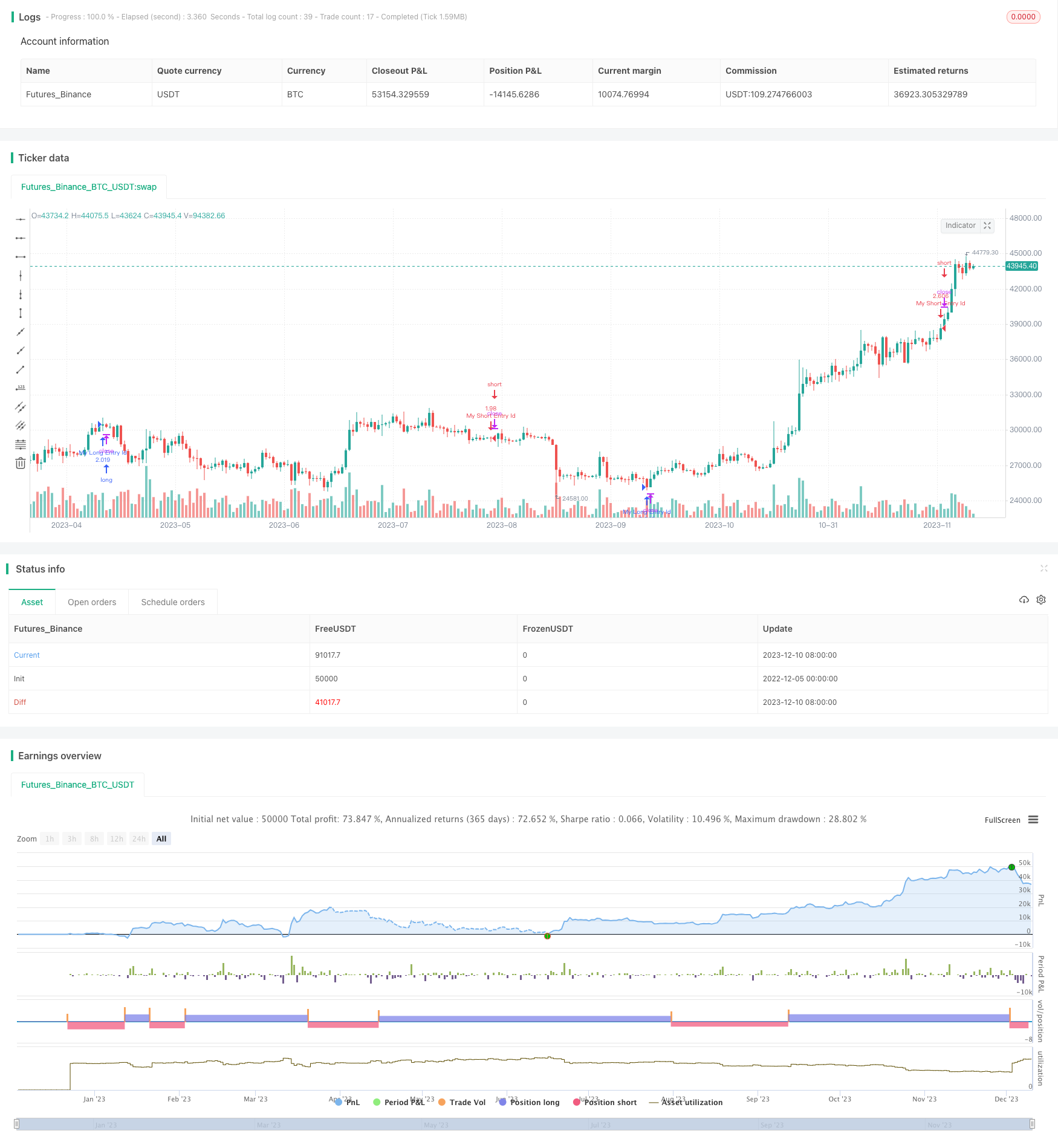
概述
本策略的核心思想是结合不同周期的RSI指标判断当前价格区域,发现较大周期RSI指标出现突破时,在较小周期采取相应的买入或卖出操作。该策略综合利用了不同周期技术指标的优势,通过多个时间维度判断当前价格的相对价值,寻找较优的入场点位。
策略原理
本策略主要通过以下几个步骤判断价格区域并寻找交易机会:
- 计算较大周期(例如日线)的RSI指标的最高点(Swing High)和最低点(Swing Low)
- 判断较大周期RSI在给定回看周期内是否出现最高或最低点
- 如果出现突破,则在较小周期(例如5分钟线)判断价格走势(多头或空头),采取相应的买入或卖出操作
例如,当日线RSI指标出现突破新高时,我们判断目前处于多头行情,而如果日线RSI出现突破新低时,则判断目前处于空头行情,在这两种情况下我们分别在5分钟线上采取买入和卖出操作。
优势分析
相比传统仅关注一个时间周期的策略,本策略具有以下几个优势:
评估当前价格的相对价值更准确。日线等较大周期指标可以过滤短期市场噪音,判断大周期趋势和价值区域。
结合不同时间周期指标,提高信号的可靠性。只依赖单一周期指标容易出现错误信号,而多个周期指标同步发出信号则更加可靠。
更有效抓取短期机会。日线等大周期突破为我们指明大的方向,而我们只需要在5分钟等短周期寻找机会就可以获利。
回撤更小。跨时间周期结合,有助于避免被套。当大周期指标发生转折时,我们将及时止损退出。
风险分析
本策略的主要风险在于:
大周期指标判断错误。当日线RSI等指标无法有效判断价值区域时,会导致信号产生错误。这需要优化RSI的参数设定。
小周期行情与大周期判断不符。有时候小周期价格走势会对抗大周期趋势,这时需要设定止损来控制损失。
资金管理不当。如果风险管理不当,单次损失过大,会导致难以恢复。这需要合理设定仓位管理。
优化方向
本策略的优化空间还很大,主要可以从以下几个方面入手:
周期参数优化。可以测试更多的周期组合,寻找最佳参数。
RSI参数优化。可以调整RSI的参数看看是否可以提高判断准确性。
增加其他指标。可以加入更多指标进行组合,例如加上均线判断趋势方向。
优化止损机制。可以根据回撤情况动态调整止损点。
优化仓位管理。可以更科学合理的管理每次交易的具体仓位。
总结
本策略通过评估跨周期的RSI指标看涨情况,实现不同时间维度之间的价值套利。这种跨周期判断的思路值得进一步挖掘,我们可以通过参数优化、止损优化、组合优化等方法不断完善,使得策略更具优势。总的来说,本策略具有独特的思路和很大的优化空间。
/*backtest
start: 2022-12-05 00:00:00
end: 2023-12-11 00:00:00
period: 1d
basePeriod: 1h
exchanges: [{"eid":"Futures_Binance","currency":"BTC_USDT"}]
*/
//@version=3
strategy("Swing MTF", shorttitle="Swing MTF", overlay=false, default_qty_type = strategy.percent_of_equity, default_qty_value = 100, initial_capital = 10000, slippage = 5)
//
otf_period = input(defval=2, title="Look Back Period (2nd Timeframe)")
otf = input(defval="180", title="Second Momentum Timeframe")
// Function to dectect a new bar
is_newbar(res) =>
t = time(res)
change(t) != 0 ? true : false
// Check how many bars are in our upper timeframe
since_new_bar = barssince(is_newbar(otf))
otf_total_bars = na
otf_total_bars := since_new_bar == 0 ? since_new_bar[1] : otf_total_bars[1]
//Calculate RSI Values
ctf_rsi = rsi(open, otf_period)
breakline=input(title="Breaks in lines", defval = true, type=bool)
so = request.security(syminfo.tickerid, otf, rsi(open, otf_period))
sc = request.security(syminfo.tickerid, otf, rsi(close, otf_period))
final_otf_so = na
final_otf_so := barstate.isrealtime ? since_new_bar == otf_total_bars ? so : final_otf_so[1] : so
final_otf_sc = na
final_otf_sc := barstate.isrealtime ? since_new_bar == otf_total_bars ? sc : final_otf_sc[1] : sc
barsback = input(11, title='Bars back to check for a swing')
// showsig = input(false, title='Show Signal Markers')
swing_detection(index)=>
swing_high = false
swing_low = false
start = (index*2) - 1 // -1 so we have an even number of
swing_point_high = final_otf_so[index]
swing_point_low = final_otf_sc[index]
//Swing Highs
for i = 0 to start
swing_high := true
if i < index
if final_otf_so[i] > swing_point_high
swing_high := false
break
// Have to do checks before pivot and after seperately because we can get
// two highs of the same value in a row. Notice the > and >= difference
if i > index
if final_otf_so[i] >= swing_point_high
swing_high := false
break
//Swing lows
for i = 0 to start
swing_low := true
if i < index
if final_otf_sc[i] < swing_point_low
swing_low := false
break
// Have to do checks before pivot and after seperately because we can get
// two lows of the same value in a row. Notice the > and >= difference
if i > index
if final_otf_sc[i] <= swing_point_low
swing_low := false
break
[swing_high, swing_low]
// Check for a swing
[swing_high, swing_low] = swing_detection(barsback)
long = final_otf_so > final_otf_sc
short = final_otf_so < final_otf_sc
if swing_low and long
strategy.entry("My Long Entry Id", strategy.long)
if swing_high and short
strategy.entry("My Short Entry Id", strategy.short)